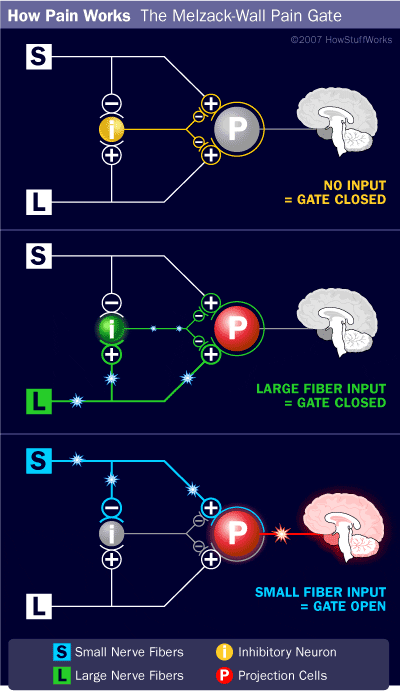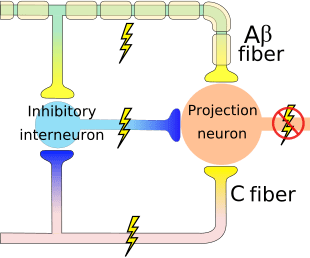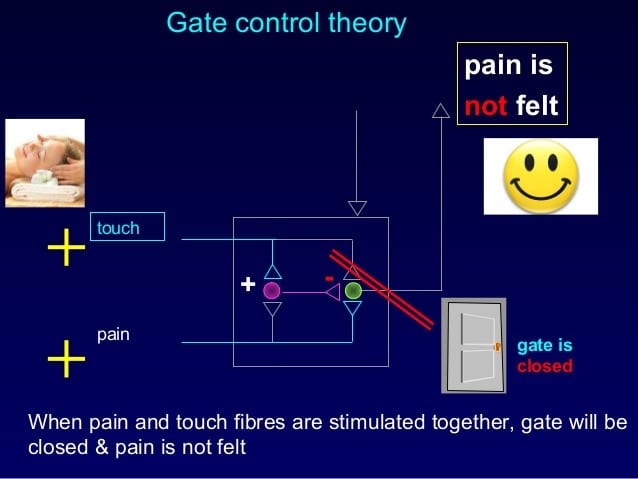Pain perception varies across different people based on their mood, psychological condition and previous experience, even when pain is brought on by similar physical stimulation and ends in a similar level of damage. In 1965, Ronald Melzack and Patrick Wall summarized a scientific theory about the psychological influence on pain perception; known as the gate control theory.
If it wasn’t for this theory, pain perception would still be connected to the intensity of the pain stimulation and the degree of damage caused to the affected tissue. But Melzack and Wall made it clear that pain perception is far more complicated than we believe.
Based on the gate control theory, pain signals aren’t free to travel to the brain as soon as they’re generated in the region of the damaged or injured tissues. These first need to encounter specific neural gates found at the level of the spinal cord level, where these gates ascertain whether the pain signals should reach the brain or not. To put it differently, pain is perceived when the gate gives way to the pain signals and it is not as intense or it is not sensed at all when the gate closes for the signs to pass through.
This theory provides the explanation for why people find relief by massaging or rubbing a damage, injured or painful site. Although the gate control theory cannot demonstrate the whole picture of the fundamental system which underlies pain, it’s visualized the mechanism of pain perception and it has created a pathway to various pain management treatment approaches.
Table of Contents
Nerve Fibers in Transmission of Sensory Signals
Every organ, or portion of the human body, has its own nerve supply which are in charge of carrying electric impulses generated in reaction to several senses, such as touch, temperature, pressure and pain. These nerves, which make up the peripheral nervous system, transmit these sensory signals, to the central nervous system, or the brain and the spinal cord. These impulses are then translated and perceived as senses. The peripheral nerves send signals to the dorsal horn of the spinal cord and from there, the sensory signals are transmitted into the brain through the spinothalamic tract. Pain is a sensation which alarms a person that a tissue or certain portion of the human body has been damaged or injured.
Due to their axonal diameter and their conduction speed, nerve fibers can be categorized into three different types, nerve fibers A, B and C. The C fibers are considered to be the smallest among the three different types. Moreover, there are four subtypes within the A fibers: A-alpha, A-beta, A-gamma and A-delta. From the A fiber subtypes, the A-alpha fibers are the largest and the A-delta fibers are the smallest.

The A fibers which are larger compared to the A-delta fibers, carry sensations, such as touch, pressure, etc., into the spinal cord. The A-delta fibers as well as the C fibers carry pain signals into the spinal cord. A-delta fibers are faster and carry sharp pain signals while the C fibers are slower and carry diffuse pain signals.
When thinking about that the conduction velocity of nerve fibers, the A-alpha fibers, which are the biggest A nerve fibers, have greater conduction speed compared to A-delta fibers and C fibers, which are considered to be the smallest nerve pathways. When a tissue is damaged or injured, the A-delta fibers are activated first, followed by the activation of the C fibers. These nerve fibers have a tendency to carry the pain signals to the spinal cord and then to the brain. However, the pain signals are transmitted through a much more complex process than what is simply explained above.
Ascending Tracts | Pain Modulation: Gate Control Theory
What is the Gate Control Theory of Pain?
The gate control theory implies that the sensory signals or impulses which are transmitted by the nerve fibers encounter neural gates at the level of the spinal cord and these will need to get cleared through those gates to reach the brain. Various factors determine how the pain signals ought to be treated in the neurological gates, including:
- The intensity of the pain signals
- The degree of another sensory signal, such as touch, temperature and pressure, if produced at the site of damage or injury
- The message from the brain itself to deliver the pain signals or not
As previously mentioned, the nerve fibers, both large and small, carrying the sensory signals, end in the dorsal horn of the spinal cord from where the impulses are transmitted into the brain. According to the original postulate of Melzack and Wall, the nerve fibers project to the substantia gelatinosa, or SG, of the dorsal horn and the initial central transmission (T) cells of the spinal cord. The SG consists of inhibitory interneurons that behave as the gate and ascertain which sensory signals should get to the T cells then go further throughout the spinothalamic tract to finally reach the brain.
When the pain signals carried by the small nerve fibers, or the A-delta fibers and the C fibers, are somewhat less intense compared to another non-pain sensory signal like touch, temperature and pressure, the inhibitory neurons stop the transmission of the pain signals through the T cells. The non-pain signals override the pain signals and therefore the pain is not perceived by the brain. When the pain signals are somewhat more intense compared to the non-pain signals, the inhibitory neurons are inactivated and the gate is opened. The T cells transmit the pain signals into the spinothalamic tract which carries those impulses to the brain. As a result, the neurological gate is influenced by the relative amount of activity from the large and the small nerve fibers.


How Emotions and Thoughts Affect Pain
The gate control theory also suggests that the pain signal transmission could be affected by thoughts and emotions. It’s well known that people do not feel that a chronic pain or, more appropriately, the pain does not disturb them if they concentrate on other activities which interest them. Whereas, people who are depressed or anxious may often feel intense pain and can also find it challenging to cope with. This is due to the fact that the brain sends messages through descending nerve fibers which stop, reduce or enhance the transmission of pain signals through the gate, depending on the emotions and thoughts someone may be going through.
Gate Control Theory in Pain Management
The gate control theory has caused a radical revolution within the field of pain management. The theory suggested that pain management can be accomplished by influencing the larger nerve fibers that carry non-pain stimulation. The concept has also paved way for more research on cognitive and behavioral strategies to achieve pain relief.
Among the most tremendous advances in pain management research is the arrival of Transcutaneous Electrical Nerve Stimulation (TENS). The gate control theory forms the cornerstone of TENS. In this procedure, the selective stimulation of the large diameter nerve fibers taking non-pain sensory stimulation from a particular region nullifies or reduces the impact of pain signals from the region. TENS is a non-invasive and affordable pain control strategy that has been widely used for the treatment of chronic and intractable pain by various healthcare professionals, which may otherwise have been non-responsive to analgesics and surgical interventions. TENS is tremendously advantageous over pain drugs from the aspect that it does not have the problem of medication interactions and toxicity.
For instance, many doctors of chiropractic, or chiropractors, utilize TENS and other electrotherapeutic procedures in their practice. These are generally utilized along with spinal adjustments and manual manipulations to increase circulation as well as to aid in the support of chiropractic care. Several other invasive and noninvasive electrical stimulation techniques are discovered to be helpful in several chronic pain conditions such as arthritic pain, diabetic neuropathy, fibromyalgia, etc.. The theory has also been extensively studied in treating chronic back pain and cancer pain. However, favorable results are not attained in some conditions and the long term efficacy of these techniques based on the theory still remains under consideration.

Dr. Alex Jimenez’s Insight
Chiropractic care is widely utilized to benefit patients with chronic pain. Symptoms of persistent pain and discomfort have become a big health issue in the United States where many years of research have found that drugs and/or medications are not necessarily a solution to the problem. The gate control theory, which was first proposed over half a century ago, has offered healthcare professionals new insights on the perception of pain, providing a variety of pain management treatment methods, such as the use of transcutaneous electrical nerve stimulation, or TENS, as well as other electrotherapeutic procedures. Chiropractors can help with pain management through spinal adjustments and manual manipulations, and through the use of TENS.
Nevertheless, the gate control theory has radically revolutionized the area of pain research and it has achieved to get numerous studies which aim at presenting a pain-free lifestyle into the patients who suffer from chronic pain. The scope of our information is limited to chiropractic as well as to spinal injuries and conditions. To discuss the subject matter, please feel free to ask Dr. Jimenez or contact us at 915-850-0900 .
Curated by Dr. Alex Jimenez
Additional Topics: Sciatica
Sciatica is medically referred to as a collection of symptoms, rather than a single injury and/or condition. Symptoms of sciatic nerve pain, or sciatica, can vary in frequency and intensity, however, it is most commonly described as a sudden, sharp (knife-like) or electrical pain that radiates from the low back down the buttocks, hips, thighs and legs into the foot. Other symptoms of sciatica may include, tingling or burning sensations, numbness and weakness along the length of the sciatic nerve. Sciatica most frequently affects individuals between the ages of 30 and 50 years. It may often develop as a result of the degeneration of the spine due to age, however, the compression and irritation of the sciatic nerve caused by a bulging or herniated disc, among other spinal health issues, may also cause sciatic nerve pain.

EXTRA IMPORTANT TOPIC: Sciatica, Pain, Symptoms and Causes
 MORE TOPICS: EXTRA EXTRA: El Paso Spine Center | Back Pain Treatment
Post Disclaimer
Professional Scope of Practice *
The information herein on "Gate Control Theory and Pain Management in El Paso, TX" is not intended to replace a one-on-one relationship with a qualified health care professional or licensed physician and is not medical advice. We encourage you to make healthcare decisions based on your research and partnership with a qualified healthcare professional.
Blog Information & Scope Discussions
Welcome to El Paso's Chiropractic Scientist wellness blog, where Dr. Alex Jimenez, DC, FNP-C, a board-certified Family Practice Nurse Practitioner (FNP-C) and Chiropractor (DC), presents insights on how our team is dedicated to holistic healing and personalized care. Our practice aligns with evidence-based treatment protocols inspired by integrative medicine principles, similar to those found on dralexjimenez.com, focusing on restoring health naturally for patients of all ages.
Our areas of chiropractic practice include Wellness & Nutrition, Chronic Pain, Personal Injury, Auto Accident Care, Work Injuries, Back Injury, Low Back Pain, Neck Pain, Migraine Headaches, Sports Injuries, Severe Sciatica, Scoliosis, Complex Herniated Discs, Fibromyalgia, Chronic Pain, Complex Injuries, Stress Management, Functional Medicine Treatments, and in-scope care protocols.
Our information scope is limited to chiropractic, musculoskeletal, physical medicine, wellness, contributing etiological viscerosomatic disturbances within clinical presentations, associated somato-visceral reflex clinical dynamics, subluxation complexes, sensitive health issues, and functional medicine articles, topics, and discussions.
We provide and present clinical collaboration with specialists from various disciplines. Each specialist is governed by their professional scope of practice and their jurisdiction of licensure. We use functional health & wellness protocols to treat and support care for the injuries or disorders of the musculoskeletal system.
Our videos, posts, topics, subjects, and insights cover clinical matters, issues, and topics that relate to and directly or indirectly support our clinical scope of practice.*
Our office has reasonably attempted to provide supportive citations and has identified the relevant research studies or studies supporting our posts. We provide copies of supporting research studies available to regulatory boards and the public upon request.
We understand that we cover matters that require an additional explanation of how they may assist in a particular care plan or treatment protocol; therefore, to discuss the subject matter above further, please feel free to ask Dr. Alex Jimenez, DC, APRN, FNP-BC, or contact us at 915-850-0900.
We are here to help you and your family.
Blessings
Dr. Alex Jimenez DC, MSACP, APRN, FNP-BC*, CCST, IFMCP, CFMP, ATN
email: coach@elpasofunctionalmedicine.com
Licensed as a Doctor of Chiropractic (DC) in Texas & New Mexico*
Texas DC License # TX5807
New Mexico DC License # NM-DC2182
Licensed as a Registered Nurse (RN*) in Texas & Multistate
Texas RN License # 1191402
ANCC FNP-BC: Board Certified Nurse Practitioner*
Compact Status: Multi-State License: Authorized to Practice in 40 States*
Graduate with Honors: ICHS: MSN-FNP (Family Nurse Practitioner Program)
Degree Granted. Master's in Family Practice MSN Diploma (Cum Laude)
Dr. Alex Jimenez, DC, APRN, FNP-BC*, CFMP, IFMCP, ATN, CCST
My Digital Business Card






 Again, We Welcome You.
Again, We Welcome You.
Comments are closed.